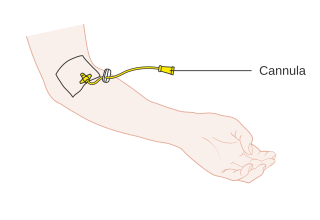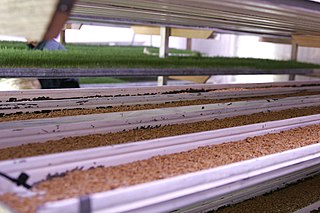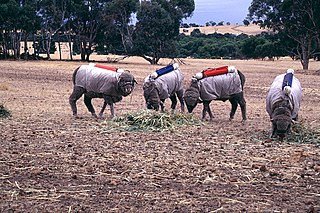Ruminal tympany, also known as ruminal bloat, is a disease of ruminant animals, characterized by an excessive volume of gas in the rumen. Ruminal tympany may be primary, known as frothy bloat, or secondary, known as free-gas bloat. [1]
In the rumen, food eaten by the ruminant is fermented by microbes. This fermentation process continually produces gas, the majority of which is expelled from the rumen by eructation (burping). [2] Ruminal tympany occurs when this gas becomes trapped in the rumen.
In frothy bloat (primary ruminal tympany), the gas produced by fermentation is trapped within the fermenting material in the rumen, causing a build up of foam which cannot be released by burping. [3] In cattle, the disease may be triggered after an animal eats a large amount of easily fermenting plants, such as legumes, alfalfa, red clover, or white clover. [1] Some legumes, such as sainfoin, birdsfoot trefoil and cicer milkvetch are not associated with causing bloat in cattle. [4] In feedlot cattle, a diet containing a high proportion of cereal grain can lead to primary ruminal tympany. [5] The main signs of bloat in cattle are distension of the left side of the abdomen, dyspnea (difficulty breathing) and severe distress. If gas continues to accumulate, the right side of the abdomen may also become distended, with death occurring in cattle within 3–4 hours after symptoms begin. [1]
In free-gas bloat (secondary ruminal tympany), gas builds up in the rumen and cannot escape, due to blockage of the esophagus. [1]

In agriculture, rotational grazing, as opposed to continuous grazing, describes many systems of pasturing, whereby livestock are moved to portions of the pasture, called paddocks, while the other portions rest. Each paddock must provide all the needs of the livestock, such as food, water and sometimes shade and shelter. The approach often produces lower outputs than more intensive animal farming operations, but requires lower inputs, and therefore sometimes produces higher net farm income per animal.

Ruminants are hoofed herbivorous grazing or browsing mammals that are able to acquire nutrients from plant-based food by fermenting it in a specialized stomach prior to digestion, principally through microbial actions. The process, which takes place in the front part of the digestive system and therefore is called foregut fermentation, typically requires the fermented ingesta to be regurgitated and chewed again. The process of rechewing the cud to further break down plant matter and stimulate digestion is called rumination. The word "ruminant" comes from the Latin ruminare, which means "to chew over again".

Lactic acidosis is a medical condition characterized by a build-up of lactate in the body, with formation of an excessively low pH in the bloodstream. It is a form of metabolic acidosis, in which excessive acid accumulates due to a problem with the body's oxidative metabolism.

A cannula is a tube that can be inserted into the body, often for the delivery or removal of fluid or for the gathering of samples. In simple terms, a cannula can surround the inner or outer surfaces of a trocar needle thus extending the effective needle length by at least half the length of the original needle. Its size mainly ranges from 14 to 26 gauge. Different-sized cannula have different colours as coded.

Fodder, also called provender, is any agricultural foodstuff used specifically to feed domesticated livestock, such as cattle, rabbits, sheep, horses, chickens and pigs. "Fodder" refers particularly to food given to the animals, rather than that which they forage for themselves. Fodder includes hay, straw, silage, compressed and pelleted feeds, oils and mixed rations, and sprouted grains and legumes. Most animal feed is from plants, but some manufacturers add ingredients to processed feeds that are of animal origin.
Burping is the release of gas from the upper digestive tract of animals through the mouth. It is usually audible.

There are different systems of feeding cattle in animal husbandry. For pastured animals, grass is usually the forage that composes the majority of their diet. Cattle reared in feedlots are fed hay supplemented with grain, soy and other ingredients to increase the energy density of the feed. The debate is whether cattle should be raised on fodder primarily composed of grass or a concentrate. The issue is complicated by the political interests and confusion between labels such as "free range", "organic", or "natural". Cattle raised on a primarily foraged diet are termed grass-fed or pasture-raised; for example meat or milk may be called grass-fed beef or pasture-raised dairy. The term "pasture-raised" can lead to confusion with the term "free range", which does not describe exactly what the animals eat.
Abdominal bloating is a short-term disease that affects the gastrointestinal tract. Bloating is generally characterized by an excess buildup of gas, air or fluids in the stomach. A person may have feelings of tightness, pressure or fullness in the stomach; it may or may not be accompanied by a visibly distended abdomen. Bloating can affect anyone of any age range and is usually self-diagnosed, in most cases does not require serious medical attention or treatment. Although this term is usually used interchangeably with abdominal distension, these symptoms probably have different pathophysiological processes, which are not fully understood.
The rumen, also known as a paunch, is the largest stomach compartment in ruminants and the larger part of the reticulorumen, which is the first chamber in the alimentary canal of ruminant animals. The rumen's microbial favoring environment allows it to serve as the primary site for microbial fermentation of ingested feed. The smaller part of the reticulorumen is the reticulum, which is fully continuous with the rumen, but differs from it with regard to the texture of its lining.
Streptococcus bovis is a species of Gram-positive bacteria that in humans is associated with urinary tract infections, endocarditis, sepsis, and colorectal cancer. S. gallolyticus is commonly found in the alimentary tract of cattle, sheep, and other ruminants, and may cause ruminal acidosis or feedlot bloat. It is also associated with spontaneous bacterial peritonitis, a frequent complication occurring in patients affected by cirrhosis. Equivalence with Streptococcus equinus has been contested.

Enteric fermentation is a digestive process by which carbohydrates are broken down by microorganisms into simple molecules for absorption into the bloodstream of an animal. Because of human agricultural reliance in many parts of the world on animals which digest by enteric fermentation, it is one of the factors in increased methane emissions.

A trocar is a medical or veterinary device used in minimally invasive surgery, typically made up of an awl, a cannula and often a seal, and some trocars also include a valve mechanism to allow for insufflation. Trocars are designed for placement through the chest and abdominal walls during thoracoscopic and laparoscopic surgery, and each trocar functions as a portal for the subsequent insertion of other endoscopic instruments such as grasper, scissors, stapler, electrocautery, suction tip, etc. — hence the more commonly used colloquial jargon "port". Trocars also allow passive evacuation of excess gas or fluid from organs within the body.
Fog fever is a refeeding syndrome in cattle, clinically named acute bovine pulmonary emphysema and edema (ABPEE) and bovine atypical interstitial pneumonia. This veterinary disease in adult cattle follows an abrupt move from feedlot to 'foggage pasture'. Clinical signs begin within 1 to 14 days and death may follow within 2 to 4 days. The condition can affect up to 50% of the herd, and around 30% of affected cattle may die as a result. This metabolic nutritional-respiratory disturbance has also been reported in other ruminants and on a wide variety of grasses, alfalfa, rape, kale, and turnip tops.
Slafractonia leguminicola is a fungus that is a plant pathogen that most often attaches itself to the Trifolium pratense or red clover. It is also called black patch disease. The infection is first seen as small black patches on the leaves of red clover and spreads to cover the entire plant, killing it. The hyphae of this fungus are white and web-like in appearance, just like those of other fungi. The consumption of the fungus can be harmful to any grazing animals, especially to horses and cows.
Abomasitis is a relatively rare ruminant disease characterized by inflammation of abomasum usually caused by larval development in young calves, lambs, and goat kids. It occurs with gastroenteritis, but can also be a side effect of other diseases. However, it is seldom diagnosed as a separate condition.
Erle E. Bartley was an Agricultural Science Professor at Kansas State University from 1949 until his death in 1983. He was known for his many agricultural inventions, especially those regarding ruminal tympany problems. He invented the bloat preventative poloxalene, also known as "Bloat Guard".

Grass tetany is a metabolic disease involving magnesium deficiency, which can occur in such ruminant livestock as beef cattle, dairy cattle and sheep, usually after grazing on pastures of rapidly growing grass, especially in early spring.
Karen Beauchemin is a federal scientist in Canada who is recognized as an international authority on methane emissions and ruminant nutrition. Her research helps develop farming techniques that improve how we raise cattle for meat and milk, while reducing the environmental impacts of livestock production.
Methanogens are a group of microorganisms that produce methane as a byproduct of their metabolism. They play an important role in the digestive system of ruminants. The digestive tract of ruminants contains four major parts: rumen, reticulum, omasum and abomasum. The food with saliva first passes to the rumen for breaking into smaller particles and then moves to the reticulum, where the food is broken into further smaller particles. Any indigestible particles are sent back to the rumen for rechewing. The majority of anaerobic microbes assisting the cellulose breakdown occupy the rumen and initiate the fermentation process. The animal absorbs the fatty acids, vitamins and nutrient content on passing the partially digested food from the rumen to the omasum. This decreases the pH level and initiates the release of enzymes for further breakdown of the food which later passes to the abomasum to absorb remaining nutrients before excretion. This process takes about 9–12 hours.

FutureFeed is a seaweed-based feed ingredient for livestock that is currently being developed by a team from Australia's Commonwealth Scientific and Industrial Research Organisation (CSIRO). The primary component of FutureFeed is dried Asparagopsis, a genus of red algae, which has been shown to reduce the methane (CH4) emissions of ruminant livestock by up to 99%. It is added to fodder at feedlots in dosages of 1-2% dietary intake to achieve this result. FutureFeed is currently being developed in collaboration with James Cook University (JCU) and Meat and Livestock Australia (MLA), with the primary goal of scaling for mainstream commercial use.